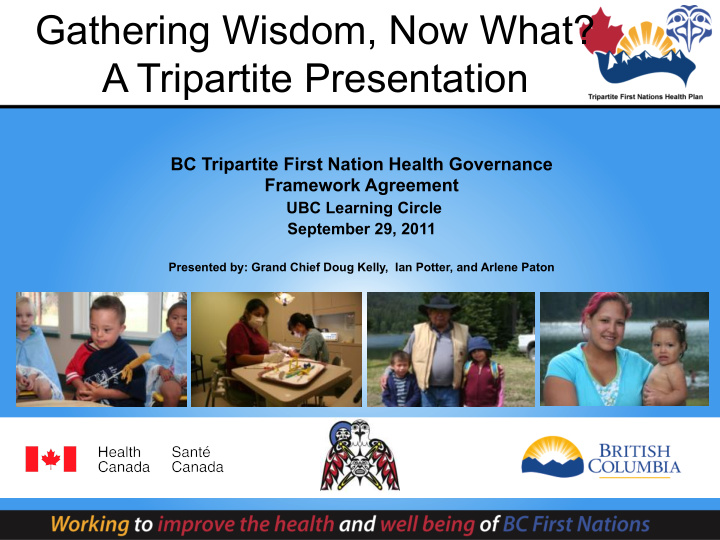



Gathering Wisdom, Now What? A Tripartite Presentation BC Tripartite First Nation Health Governance Framework Agreement UBC Learning Circle September 29, 2011 Presented by: Grand Chief Doug Kelly, Ian Potter, and Arlene Paton
Gathering Wisdom IV • Unprecedented First Nations leadership support for: – New health governance structure – Transfer of Health Canada – B.C. FNIH responsibilities to a new First Nations Health Authority – Align to seven directives – Report back May 2012
Consensus: 7 Directives • Directives describe fundamental standards and instructions for new health governance arrangement
Consensus: 7 Directives Directive Directive Directive Directive #4: #1: #2: Increase #3: Improve Foster Community- First Services Meaningful Driven, Nations Collaboration Nation- Decision- and Based Making and Partnership Control
Consensus: 7 Directives Directive Directive #6: Directive #5: Be Without #7: Develop Prejudice to Function at Human and First Nations a High Economic Interests Operational Capacity Standard
Consensus: Role of Regional Caucuses/Tables Regional Caucuses in each Health Region will establish Regional Tables to: • Engage with First Nations • Develop and implement arrangements between Regional Tables and Regional Health Authorities • Develop regional perspectives and approaches to health and wellness • Effective, efficient and sustainable engagement and operations
Consensus: Role of First Nations Health Authority PRIORITIES Engagement with First Nations Effective delivery of services including address service gaps and innovation Improve NIHB program Implement First Nations values Health literacy and self-care Health partnership with Province including shared service opportunities Capital, infrastructure, equipment Health human resource development Cultural competency training First Nations Deputy PHO Constituted with good governance, accountability, transparency and defined operating standards and governed by a Board of Directors with experience in First Nations health programs and services and successfully running a large operation.
Work plan to deliver on Resolution • As directed by leadership at Gathering Wisdom IV, a work plan developed for review by regional caucuses. • Work plan details key deliverables set out in resolution 2011-01. • Work plan to be reviewed by regional caucuses this fall.
First Nations Health Governance Structure Workbook • Final FNHA form/structure to be developed via further research, analysis, and engagement with First Nations, as led by the FNHC (2012) • Permanent structure workbook process rolled out via regional caucuses (early 2012) • First Nations to vote on permanent structure at Gathering Wisdom V (May 2010)
What does the Framework Agreement do? • Establishes a new governance structure for First Nations health – First Nations fully involved in planning, programming and delivery – A First Nations Health Authority – First Nations take over Federal Regional role – Federal and Provincial commitment to funding 12 ¡
Federal Commitments in Framework Agreement • Transfer all resources to support programs to the FNHA • Ten year block funding agreement • Implementation funding • Participation by Canada in committees in support of its role as governance partner • BC First Nations invited to Federal “ Health Determinants ” Tables
Why is the Framework Agreement Important? • First Nations involved in all aspects of their health services • Provides First Nations with governance and administrative tools for effective and efficient service • Creates long term stability
COMPARISON OF CURRENT & PROPOSED ELEMENTS Elements Current Proposed Policies & • Decisions are • Decisions are made Programs made in Ottawa in BC by BC First by federal Nations government Regional • Accountable to • Accountable to BC Management Ottawa First Nations (for day to day operations)
COMPARISON OF CURRENT & PROPOSED ELEMENTS Elements Current Proposed Health • Limited to federal • New partnership Services policies with Regional Health Authorities • Little integration • Service designed to with Provincial health system meet the needs of First Nations Funding • Year by year • 10 years stable allocation – funding uncertainty • Guaranteed annual growth
Evolving Relationship between First Nations and Federal Government • No change to fundamental relationship • No impact on First Nations rights, treaties or self government • Federal role changes to governance partner: – Collaboration on: • Social determinants of health • Sharing research and promising practices • Program design and policy • Federal Regional staff transferred to First Nations Health Authority
Transition • Transfer anticipated within two years of signing the FA • Mechanisms to support Transfer: – Canada Funding Agreement – Sub-agreement negotiations to effect the transfer – Implementation Structure – Health Partnership Accord
BC Undertakings • a commitment to explore various legislative options to establish legal authority of the FNHA and enable public health functions. • directing Health Authorities to collaborate with the FNHA at the regional level to facilitate coordination and integration of First Nations health programs and services. 19
BC Undertakings Cont ’ d • Develop a Health Partnership Accord to describe the shared vision. • Discuss “ innovative arrangements for service delivery ” where mutually agreed upon. 20
Continued Role of Province and Health Authorities • Ensure duplication will not occur and a parallel health service delivery structure will not be created. 21
Ongoing Provincial Funding Commitment • $83.5 Million to the First Nations Health Society to implement the commitments in the Transformative Change Accord and the Tripartite First Nations Health Plan. 22
Recommend
More recommend